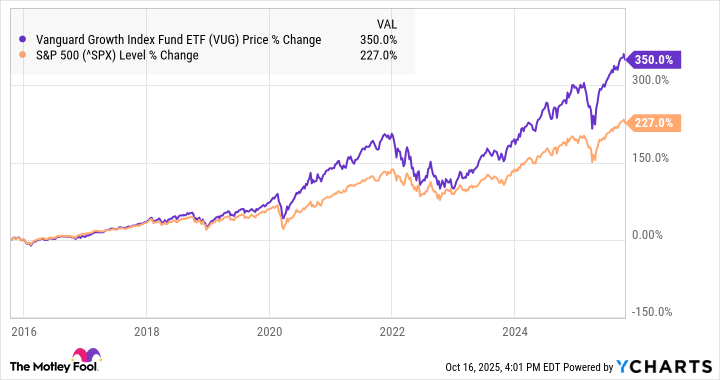Exchange-traded funds, or ETFs, have become one of the most popular ways to invest these days. Inflows to ETFs are soaring as more investors look for ways to cash in on the artificial intelligence (AI) boom. In fact, inflows into ETFs have already topped $1 trillion this year, and are expected to reach $1.4 trillion.
It's part of a trend of investors moving money from mutual funds to less-expensive and more liquid ETFs.
ETFs offer several advantages over individual stocks. They can give investors easy access to a group of stocks, such as those that track an index fund, a sector, a country, or another theme that investors are looking to get exposure to. ETFs do the hard work of picking individual stocks for you, and they're just as easy to buy and sell as individual stocks.

Image source: Getty Images.
Vanguard is one of the oldest and most trusted ETF managers, and invented the index fund, or a type of ETF that tracks an index like the S&P 500 (^GSPC +0.30%). While an S&P 500 index fund might be the gold standard in ETFs, some Vanguard ETFs have outperformed the S&P 500, especially during the recent AI boom.
In fact, there's one Vanguard ETF that is expected to outperform over the next year, and one Wall Street analyst even sees it jumping 39%.
Meet the Vanguard Growth ETF
The Vanguard Growth ETF (VUG +0.06%) has historically been a top performer on the market. As you can see from the chart below, the Vanguard Growth ETF has handily outperformed the S&P 500 over the last decade.
Data by YCharts.
As you can see, the VUG has typically outperformed the S&P 500 in bull markets, but underperformed in bear markets such as in 2022.
Over the last decade, that's proved to be a winning combination as stocks have soared. Wall Street expects that to continue over the next year as the average price target calls for the index to gain 15%, compared to just a 13% return for the Vanguard S&P 500 ETF.
What's in the Vanguard Growth ETF?
An ETF is only as good as its holdings, so it's important to understand what's in the Vanguard Growth ETF. Its top holdings are similar to what you'd find in the S&P 500, but with higher concentrations. The ETF, which tracks the CRSP US Large Cap Index, holds 160 stocks, focusing on large-cap growth companies. Currently, 62% of the index is in the technology sector, and its top eight holdings can be classified as tech stocks. Those are, in order of allocation, Nvidia, Microsoft, Apple, Alphabet, Amazon, Broadcom, Meta Platforms, and Tesla.
Those eight stocks, which represent the "Magnificent Seven" in addition to Broadcom, make up close to 60% of the index.

NYSEMKT: VUG
Key Data Points
Can the Vanguard Growth ETF jump 39% over the next year?
The Vanguard Growth ETF looks poised to be a winner, especially if the stock market continues to move higher, but a 39% gain may be a stretch even for a fund that is stacked with the top-performing tech stocks.
The ETF jumped 46% in 2023, and then another 32% in 2024, and is up 16% year to date. The 46% gain in 2023 shows a 39% jump in a year can be done, but that was in the early stages of the AI boom when tech stocks were beaten down following the 2022 bear market.
Today, the VUG is significantly more expensive, trading at a price-to-earnings ratio of 41.
That, along with questions about an AI bubble and a weakening job market, means the fund is unlikely to jump 39% over the next year. However, given its track record and the strength of its top holdings, the VUG still looks like a buy for top investors.





